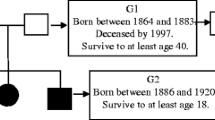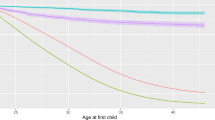Abstract
Objectives
To present details of the Norwegian Family Based Life Course Study.
Methods
All Norwegians participating in censuses from 1960 to 2001 were included. In addition to the personal identity number, we used household and family information from the 1960 census to link family members together. The NFLC study is further linked to other health registers and surveys.
Results
The proportion included and alive in 1960 increased from 67 % among those born in 1900 to more than 90 % for those born after 1940. In all, 5,266,270 were included. This combined family linkage approach gave 85 % parental linkage for those born in 1940 that dropped to 20 % of those born in 1930. The proportion with misclassified parents was less than 0.5 %. In all, 3,564,582 individuals were linked to their parents.
Conclusions
The NFLC is one of the largest follow-up of individuals over several decades in their life course. The comprehensive multigenerational, family linkage within the database contributes to large-scale use of various designs for investigating life course determinants.


Similar content being viewed by others
References
Andersen AM, Olsen J (2011) The Danish National Birth Cohort: selected scientific contributions within perinatal epidemiology and future perspectives. Scand J Public Health 39:115–120
Bao W, Threefoot SA, Srinivasan SR, Berenson GS (1995) Essential hypertension predicted by tracking of elevated blood pressure from childhood to adulthood: the Bogalusa Heart Study. Am J Hypertens 8(7):657–665
Batty GD, Mortensen EL, Nybo Andersen AM, Osler M (2005) Childhood intelligence in relation to adult coronary heart disease and stroke risk: evidence from a Danish birth cohort study. Paediatr Perinat Epidemiol 19(6):452–459
Ben-Shlomo Y, Kuh D (2002) A life course approach to chronic disease epidemiology: conceptual models, empirical challenges and interdisciplinary perspectives. Int J Epidemiol 31:285–293
Blane D, Netuveli G, Montgomery SM (2008) Quality of life, health and physiological status and change at older ages. Soc Sci Med 66(7):1579–1587
Davey Smith G (2003) ‘Mendelian randomization’: can genetic epidemiology contribute to understanding environmental determinants of disease? Int J Epidemiol 32:1–22
Davey Smith G (2008) Assessing intrauterine influences on offspring health outcomes: can epidemiological studies yield robust findings? Basic Clin Pharmacol Toxicol 102:245–256
Davey Smith G, Greenwood R, Gunnell D, Sweetnam P, Yarnell J, Elwood P (2001) Leg length, insulin resistance, and coronary heart disease risk: the Caerphilly Study. J Epidemiol Community Health 55:867–872
De Stavola BL, Nitsch D, Silva ID, McCormack V, Hardy R, Mann V et al (2006) Statistical issues in life course epidemiology. Am J Epidemiol 163(1):84–96
Ebbeling CB, Pawlak DB, Ludwig DS (2002) Childhood obesity: public-health crisis, common sense cure. Lancet 360(9331):473–482
Galobardes B (2010) Closing the gap in a generation: what more research do we need? Int J Public Health 55(5):453–455
Glymour MM (2007) Commentary: selected samples and nebulous measures: some methodological difficulties in life-course epidemiology. Int J Epidemiol 36(3):566–568
Howe LD, Tilling K, Galobardes B, Davey Smith G, Gunnell D, Lawlor DA (2012) Socioeconomic differences in childhood growth trajectories: at what age do height inequalities emerge? J Epidemiol Community Health 66(2):143–148
Korda RJ, Clements MS, Dixon J (2011) Socioeconomic inequalities in the diffusion of health technology: uptake of coronary procedures as an example. Soc Sci Med 72(2):224–229
Krieger N (2001) Theories for social epidemiology in the 21st century: an ecosocial perspective. Int J Epidemiol 30(4):668–677
Kvaavik E, Tell GS, Klepp KI (2003) Predictors and tracking of body mass index from adolescence into adulthood: follow-up of 18 to 20 years in the Oslo Youth Study. Arch Pediatr Adolesc Med 157(12):1212–1218
Lauer RM, Clarke WR (1990) Use of cholesterol measurements in childhood for the prediction of adult hypercholesterolemia. The Muscatine Study. JAMA 264(23):3034–3038
Lawlor D, Ben-Shlomo Y (2004) Pre-adult influences on cardiovascular disease. In: Kuh D and Ben-Shlomo Y (eds) A life course approach to chronic disease epidemiology, 2nd edn. Oxford University Press, Oxford
Lawlor DA, Mishra GD (2009) Family Matters. Designing, analysing and understanding family-based studies in life-course epidemiology. Oxford University Press, New York
Lawlor DA, Lichtenstein P, Fraser A, Langstrom N (2011) Does maternal weight gain in pregnancy have long-term effects on offspring adiposity? A sibling study in a prospective cohort of 146,894 men from 136,050 families. Am J Clin Nutr 94(1):142–148
Lynch J, Davey Smith G (2005) A life course approach to chronic disease epidemiology. Annu Rev Public Health 26:1–35
Magnus P, Irgens LM, Haug K, Nystad W, Skjaerven R, Stoltenberg C (2006) Cohort profile: the Norwegian Mother and Child Cohort Study (MoBa). Int J Epidemiol 35(5):1146–1150
Mamelund SE, Brunborg H, Noack T (1997) Divorce in Norway 1886–1995 by calender year and marriage cohort, Statistics Norway, Oslo-Kongsvinger
Marmot M et al (2010) The marmot review: fair society, healthy lives. Strategic review of health inequalities in England post-2010. The marmot review, London
Merlo J, Ohlsson H, Lynch KF, Chaix B, Subramanian SV (2009) Individual and collective bodies: using measures of variance and association in contextual epidemiology. J Epidemiol Community Health 63(12):1043–1048
Modin B, Fritzell J (2009) The long arm of the family: are parental and grandparental earnings related to young men’s body mass index and cognitive ability? Int J Epidemiol 38(3):733–744
Naess O, Claussen B, Thelle DS, Davey Smith GD (2004) Cumulative deprivation and cause specific mortality. A census based study of life course influences over three decades. J Epidemiol Community Health 58(7):599–603
Naess O, Leyland AH, Davey Smith G, Claussen B (2005) Contextual effect on mortality of neighbourhood level education explained by earlier life deprivation. J Epidemiol Community Health 59(12):1058–1059
Naess O, Strand BH, Davey Smith G (2007) Childhood and adulthood socioeconomic position across 20 causes of death: a prospective cohort study of 800 000 Norwegian men and women. J Epidemiol Community Health 61(11):1004–1009
Naess O, Sogaard AJ, Arnesen E, Beckstrom AC, Bjertness E, Engeland A et al (2008a) Cohort profile: cohort of Norway. Int J Epidemiol 37(3):481–485
Naess O, Claussen B, Davey Smith GD, Leyland AH (2008b) Life course influence of residential area on cause-specific mortality. J Epidemiol Community Health 62(1):29–34
Olsen J, Bronnum-Hansen H, Gissler M, Hakama M, Hjern A, Kamper-Jorgensen F et al (2010) High-throughput epidemiology: combining existing data from the Nordic countries in health-related collaborative research. Scand J Public Health 38(7):777–779
Rosen M (2002) National Health Data Registers: a Nordic heritage to public health. Scand J Public Health 30(2):81–85
Singh-Manoux A, Marmot MG, Glymour M, Sabia S, Kivimaki M, Dugravot A (2011) Does cognitive reserve shape cognitive decline? Ann Neurol 70(2):296–304
Smith BT, Lynch JW, Fox CS, Harper S, Abrahamowicz M, Almeida ND et al (2011) Life-course socioeconomic position and type 2 diabetes mellitus: the Framingham Offspring Study. Am J Epidemiol 173(4):438–447
Strand BH, Groholt EK, Steingrimsdottir OA, Blakely T, Graff-Iversen S, Naess O (2010) Educational inequalities in mortality over four decades in Norway: prospective study of middle aged men and women followed for cause specific mortality, 1960–2000. BMJ 340:c654
Sundstrom J, Neovius M, Tynelius P, Rasmussen F (2011) Association of blood pressure in late adolescence with subsequent mortality: cohort study of Swedish male conscripts. BMJ 342:d643
Vassenden K (1987) Folke-og boligtellingene 1960, 1970 og 1980. Dokumentasjon, Central Bureau of Statistics of Norway, Oslo, 87/2
Author information
Authors and Affiliations
Corresponding author
Additional information
This article is part of the special issue “Life course influences on health and health inequalities: moving toward a Public Health perspective”.
Rights and permissions
About this article
Cite this article
Næss, Ø., Hoff, D.A. The Norwegian Family Based Life Course (NFLC) study: data structure and potential for public health research. Int J Public Health 58, 57–64 (2013). https://doi.org/10.1007/s00038-012-0379-4
Received:
Revised:
Accepted:
Published:
Issue Date:
DOI: https://doi.org/10.1007/s00038-012-0379-4




